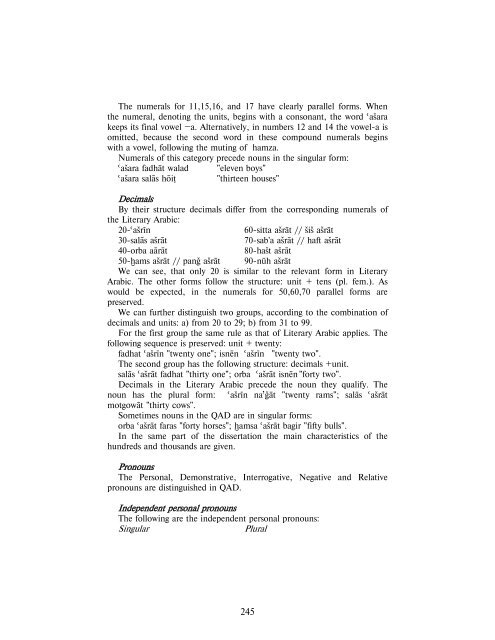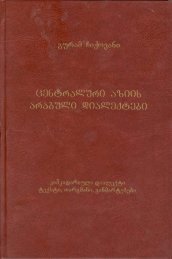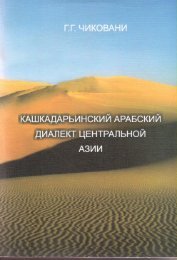- Page 2 and 3:
GEORGIAN ACADEMY OF SCIENCES TSERET
- Page 4 and 5:
naSromSi warmodgenilia Sua aziis ka
- Page 6 and 7:
Sinaarsi Sesavali 10 Tavi I. fonolo
- Page 8 and 9:
e) VIII Tema 123 v) X Tema 124 $ 17
- Page 10 and 11:
g) adgilis garemoebiTi damokidebuli
- Page 12 and 13:
naTqvami ise ar unda gavigoT, TiTqo
- Page 14 and 15:
Sua aziis buxarisa da kaSka-dariis
- Page 16 and 17:
akad. g i o r g i w e r e T l i s d
- Page 18 and 19:
Suaaziuri arabuli iZleva uaRresad m
- Page 20 and 21:
emorCilebodnen. mmarTvelebi atarebd
- Page 22 and 23:
xorezmis damorCilebis Semdeg kuTaib
- Page 24 and 25:
soRdis momaval mmarTvelad undodaT d
- Page 26 and 27:
mir hazori dgas. cnobilia, rom avRa
- Page 28 and 29:
tradiciis Tanaxmad, istoriul movlen
- Page 30 and 31:
zmna rogorc warmoebiT, aseve gaxmov
- Page 32 and 33:
a) yiSlaR jeÁnaus mcxovreblebSi da
- Page 34 and 35:
himiari (himyÁr), hijazuri (ÔiÓ
- Page 36 and 37:
uxarisa da kaSka-dariis arabulenova
- Page 38 and 39:
xoramSahri muqala mx. r mr. r. mx.
- Page 40 and 41:
dialeqti (samxreT-aRmosavleTi iemen
- Page 42 and 43:
arab raboT (arab rabÝt), raboTi ar
- Page 44 and 45:
Tbilisis ivane javaxiSvilis saxelob
- Page 46 and 47:
agreTve, diftongTa reduqciis Sedega
- Page 48 and 49:
Tavi I fonologia naSromSi kaSka-dar
- Page 50 and 51:
artikulaciis adgili artikulaciis ra
- Page 52 and 53:
emfatizacias ganicdian /Ü/ /È/ /r
- Page 54 and 55:
8. abruptivi/araabruativi; 9. perif
- Page 56 and 57:
fonemebi dif. niSnebi b p w f d t z
- Page 58 and 59:
Ôalap/Ôalaf “alepo”/”fici
- Page 60 and 61:
âÁb/ÓÁb “ymawvili”/ “moit
- Page 62 and 63:
kad-is fonemaTa distribucia cxrili
- Page 64 and 65:
dentalebi rogorc zemoT aRvniSneT, i
- Page 66 and 67:
formebSi, rac damaxasiaTebelia sxva
- Page 68 and 69:
Ôarr “cxeli” - Ôurr “Tavisu
- Page 70 and 71:
“Zili”. o-s varianti û Zalian
- Page 72 and 73:
a) akomodacia akomodacia gulisxmobs
- Page 74 and 75:
d. progresuli, nawilobrivi, distanc
- Page 76 and 77:
ãiãla÷ < tiãla÷ “gamodis (md
- Page 78 and 79:
sityvis dasawyisSi SeiZleba amovard
- Page 80 and 81:
Tavi II morfologia am nawilSi dadge
- Page 82 and 83:
ib‘ir - i‘b×r “aqlemi” sav
- Page 84 and 85:
v) C1 u C2 u C3 magaliTebi: a) fara
- Page 86 and 87:
g) C1æC2 d) C1ÎC2 e) C1×C2 magal
- Page 88 and 89:
magaliTebi: a) ilÔÁf “saxedari
- Page 90 and 91:
$ 7. ricxvis kategoria kad-Si, klas
- Page 92 and 93:
a) pirveli aTeuli sqesSi cvalebadob
- Page 94 and 95:
aq mxolod oci (‘aâr×n) iCens ms
- Page 96 and 97:
e) aTaseulebi aTaseulebs ricxviT sa
- Page 98 and 99:
sÁlisî mesame hÁâitî merve rÝ
- Page 100 and 101:
funqciiT da, meores mxriv, am nacva
- Page 102 and 103:
gvxvdeba agreTve forma mÁhad < mÁ
- Page 104 and 105:
md. liÔig-ti - t - i - I liÔig-t
- Page 106 and 107:
II tipi mx. r. piri sqesi ricxvi II
- Page 108 and 109:
âarabat ~âarabît “man dalia /
- Page 110 and 111:
mx. r. piri sqesi ricxvi III mamr.
- Page 112 and 113:
mx. r. I tipi II tipi rakab - "Sejd
- Page 114 and 115:
II tipi kitif “SeuerTda” mx. r.
- Page 116 and 117:
md. ÷amalÁn tisÙnna//÷amalÁn i
- Page 118 and 119:
$ 16. nawarmoebi Temebi 1 nawarmoeb
- Page 120 and 121:
a) II/III Tema perfeqtivi: C1aCCaC/
- Page 122 and 123:
md. tenã×n tenãÙnna I anã× na
- Page 124 and 125:
imperfeqtivi: ienC1aC2iC3 mx. r. mr
- Page 126 and 127:
$ 17. oTxTanxmovniani zmna oTxTanxm
- Page 128 and 129:
$ 18. zmnis upiro formebi a) mimReo
- Page 130 and 131:
a) taqÁtalÁn “xelCarTuli brZola
- Page 132 and 133:
md. iriââÙnna iÔuããÙnna II m
- Page 134 and 135:
masdari iwarmoeba Án bolosarTis sa
- Page 136 and 137:
) 1 2 3 (zmnebi meore Zireuli hamzi
- Page 138 and 139:
d) hamziani zmnebis imperativi qvem
- Page 140 and 141:
“mqadagebeli”. vinaidan nawarmo
- Page 142 and 143:
unda aRiniSnos, rom zmnas nasa’a
- Page 144 and 145:
I aguf naguf rogorc uRlebis cxrilid
- Page 146 and 147:
mx. r. mr. r. III mamr. Òada Òada
- Page 148 and 149:
X istÁC2iC3: istÁsi‘ v) susti z
- Page 150 and 151:
1-el TemaSi fiqsirdeba rogorc moqme
- Page 152 and 153:
imperativi: mx. r. mr. r. II mamr.
- Page 154 and 155:
3. kompozitebi sinonimuri mniSvnelo
- Page 156 and 157:
“avida”, “moevlina”. aq inf
- Page 158 and 159:
Óuwa ÓudÝ ks×r, min barra “Si
- Page 160 and 161:
aseve rTuli nawilakia iâqÝ “sad
- Page 162 and 163:
Sorisdebulebi gamoxataven gakvirveb
- Page 164 and 165:
waladak farasu “Seni biWis cxeni
- Page 166 and 167:
“Cveni qalebi (colebi) did oTaxSi
- Page 168 and 169:
hÁza abæ umma arab “misi deda (
- Page 170 and 171:
16. É× “ra?” CamoTvlili forme
- Page 172 and 173:
zogierTi konstruqcia uzbekuris anal
- Page 174 and 175:
mamin iúÔÝÖã “saxlSi aravin
- Page 176 and 177:
verbali winadadebis Semasmeneli gam
- Page 178 and 179:
“[rogorc Zvel] TqmulebebSi ambavs
- Page 180 and 181:
kvlevis TvalsazrisiTac. kad-Si gamo
- Page 182 and 183:
Semdeg faSam - “es biWi momgvareT
- Page 184 and 185:
“faSam dainaxa, rom ar waiyvanes
- Page 186 and 187:
v) miznis garemoebiTi damokidebuli
- Page 188 and 189:
$ 2. mniSvnelobaTa modifikaciebi di
- Page 190 and 191:
paraleluri formebi: kad-Si dasturde
- Page 192 and 193:
”beim biWs uTxra, lamazi (qali) m
- Page 194 and 195:
"zamTris" Sesatyvisi "zoTonji" . aR
- Page 196 and 197: - rayyatun mr. riyyÁtun “erTjera
- Page 198 and 199: sololakis baRebs. igi wyals awvdida
- Page 200 and 201: TvisiT CveniT gvenebos Suris geba,
- Page 202 and 203: ÷iâÁrun mr. ÷uâarÁöu make aq
- Page 204 and 205: “CxaberZula-i (gur.) vazis jiSia
- Page 206 and 207: daCamiCebuli); arabuli ÷aq×datun,
- Page 208 and 209: sana “weli” sanawÁt mÁÊ×
- Page 210 and 211: t×ra “qaTami” Õuræs “mamal
- Page 212 and 213: daskvna kaSka-dariulma dialeqtma ar
- Page 214 and 215: guturaluri TanxmovnebiT gamowveuli
- Page 216 and 217: Turquli izafeti da determinatiuli k
- Page 218 and 219: 17. Ciqovani g., damxmare sityvebi
- Page 220 and 221: 53. Вайнрайх У., Одно
- Page 222 and 223: 93. Маляров Ю. И., Миш
- Page 224 and 225: 128. Чиковани Г. Г., Не
- Page 226 and 227: 165. Ingham B., Modality in the Ara
- Page 228 and 229: 198. Vinnikov I. N., Materialen zur
- Page 230 and 231: CENTRAL ASIAN ARABIC DIALECTS QASHQ
- Page 232 and 233: coordinate diglossia (triglossia) a
- Page 234 and 235: The present work aims at filling th
- Page 236 and 237: ight up to the present day. As to i
- Page 238 and 239: The distinctive feature of compactn
- Page 240 and 241: The QAD consonant Ó is devoiced in
- Page 242 and 243: Positional modifications of sounds
- Page 244 and 245: egards mainly to the Uzbek and Taji
- Page 248 and 249: Singular Plural III m. -a (h) III m
- Page 250 and 251: The dual is not represented in the
- Page 252 and 253: Õaza~iÝÕuz “to take” Among v
- Page 254 and 255: (smth.)”, nÝkul nÁyimÙnni -
- Page 256 and 257: mÝrata il-gÁda mÝy Òasala “Hi
- Page 258 and 259: poâÝ iúgappÁt iúbÝi ÓudÝ Õ
- Page 260 and 261: Among foreign words, mainly Uzbek a





